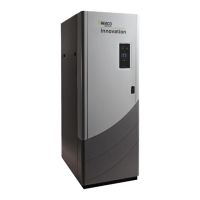Innovation - Edge [i] Installation, Operation, Maintenance Manual
CHAPTER 4 – INITIAL START-UP
4.3 COMBUSTION CALIBRATION
Innovation Water Heaters are combustion calibrated at the factory prior to shipping. However,
recalibration is necessary as part of initial start-up due to changes in the local altitude, gas BTU
(kW) content, gas supply piping and supply regulators. It is important to perform the combustion
calibration procedure, as it provides optimum performance and keep readjustments to a
minimum. Start-Up & Registration Test Data sheets are shipped with each unit. These sheets
must be filled out and returned to AERCO for proper Warranty Validation.
The unit is shipped from the factory set up for Natural Gas, as specified by the Style Number on
the Sales Order. Both fuel types require different combustion calibration values, but are otherwise
identical.
If you press the Back or Home buttons at any time before completion, the calibration operation is
disabled and normal operation resumes.
Complete the instructions below to perform combustion calibration.
1. Ensure that the Controller’s Enable/Disable switch is set to Disable.
2. Ensure that external AC power to the unit is ON.
3. Ensure that the water supply and return valves to the unit are open and that the system
pumps are running.
4. Open the main manual gas supply shut-off valve upstream of the unit.
5. On the Controller, go to: Main Menu → Calibration → Combustion.
6. The first Combustion Calibration screen appears lists the three steps that must be
completed before continuing. Complete these steps then press Next to continue.
Figure 4.3-1: First Combustion Calibration Screen
• Verify that the incoming (upstream) gas pressure to the unit is within the allowable
range, per the Innovation-Edge Gas Supply Design Guide (TAG-0091, GF-5036).
• Install the following devices on the unit:
o A gas pressure manometer downstream of the SSOV (see Section 4.2.2).
o A combustion analyzer probe in the exhaust manifold (see Section 4.2.3).
o A multimeter to read flame strength and combustion analysis (see Section 4.2.4).
• Ensure the unit has sufficient heat dissipation at full fire to avoid over-temperature
conditions. If demand is low, you can reduce the amount of heat that needs to be
dissipated, either by completing combustion calibration quickly or using a hose
attached to the drain valve on the hot water outlet to generate additional flow.

